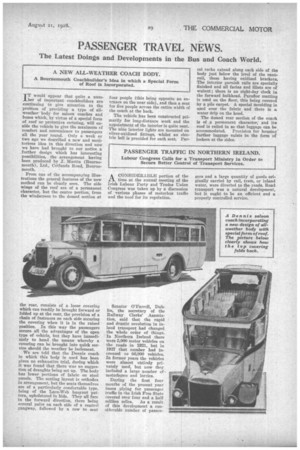PASSENGER TRAVEL NEWS.
Page 29

If you've noticed an error in this article please click here to report it so we can fix it.
The Latest Doings and Developments in the Bus and Coach World.
A NEW ALL-WEATHER COACH BODY.
A Bournemouth Coachbuilder's Idea in which a Special Form of Roof is Incorporated.
IT would appear that quite a nuraber of important coachbuilders are continuing to give attention to the problem of providing a type of allweather body for saloon coaches and buses which, by virtue of a special form of roof or protective covering, will enable the vehicle to give the maximum of comfort and convenience to passengers all the year round. Only a week or two ago we described a new and meritorious idea in this direction and now we have had brought to our notice a further design which has interesting Possibilities, the arrangement having been produced by J. Martin (Bournemouth), Ltd., Cotlands Road, Bournemouth. .
From one of the accompanying illustrations the general features of the new method can be clearly seen. The side wings of the roof are of a permanent character, but the centre portion, from the windscreen to the domed section at the rear, consists of a loose covering which can readily be brought forward or folded up at the rear, the provision of a chain of fasteners on each side securing the covering when it is in the raised position. In this way the passengers secure all the advantages of the open type of vehicle, but they have immediately to hand the means whereby a covering can be brought into quick service should the weather be inclement.
We are told that the Dennis coach in which this body is used has been given an exhaustive trial, during which it was found that there was no suggestion of draughts being set up. The body has lower portions of fabric on steel panels. The seating layout is orthodox in arrangement, but the seats themselves are of a particularly comfortable type, being of the Lace-Web buoyant pattern, upholstered in hide. They all face in the forward direction, there being several pairs on each side of a central gangway, followed by a row to seat four people (this being opposite an entrance on the near side), and then a seat for five people across the entire width of the coach at the back.
The vehicle has been constructed primarily for long-distance work and the appointment of the interior is quite neat. The nine interior lights are mounted on silver-oxidized fittings, whilst an electric bell is provided for each seat. Par
eel racks extend along each side of the body just below the level of the contrail, these having oxidized brackets. The interior garnish rails are specially finished and all facies anti fillets are of walnut ; there is an eight-day clock in the forward bulkhead. Paraflor matting is used on the floor, this being covered by a pile carpet. A special Moulding is used over the fabric and there is a water drip on the hood.
The domed rear section of the coach is of n permanent character; and its roof is railed in so that luggage can be accommodated. Provision for housing further luggage exists in the form of lockers at the sides.


































